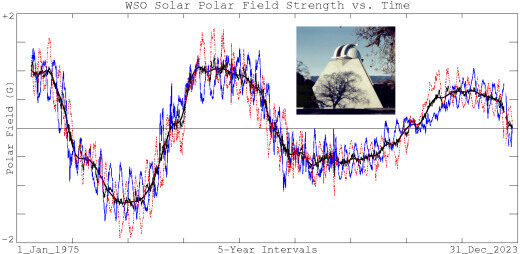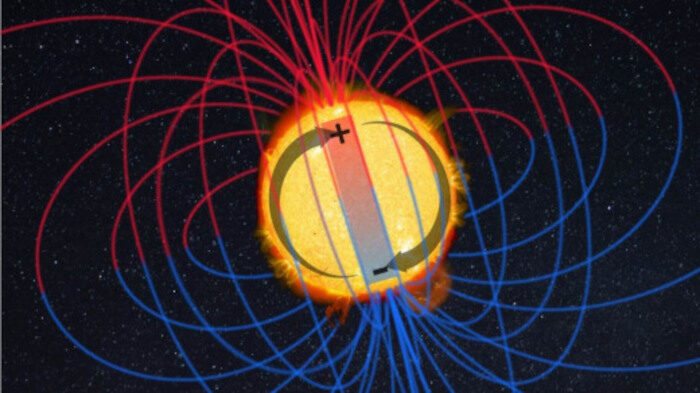Recent measurements by NASA's Solar Dynamic Observatory reveal a rapid weakening of magnetic fields in the polar regions of the sun. North and south magnetic poles are on the verge of disappearing. This will lead to a complete reversal of the sun's global magnetic field perhaps before the end of the year.
If this were happening on Earth, there were be widespread alarm. Past reversals of our planet's magnetic field have been linked to calamities ranging from sudden climate change to the extinction of Neanderthals. On the sun, it's not so bad.
"In fact, it's routine," says Todd Hoeksema, a solar physicist at Stanford University. "This happens every 11 years (more or less) when we're on the verge of Solar Maximum."
Vanishing poles and magnetic reversals have been observed around the peak of every single solar cycle since astronomers learned to measure magnetic fields on the sun. Hoeksema is the director of Stanford's Wilcox Solar Observatory (WSO), that is observing its fifth reversal since 1980.

Sometimes the transition is swift, taking only a few months for the poles to vanish and reappear on opposite ends of the sun. Sometimes it takes years, leaving the sun without magnetic poles for an extended period of time.
"Even more strange," says Hoeksema, "sometimes one pole switches before the other, leaving both poles with the same polarity for a while."
Indeed, such a scenario could be playing out now. The sun's south magnetic pole has almost completely vanished, but the north magnetic pole is still hanging on, albeit barely.
How does all this effect us on Earth? One way we feel solar field reversals is via the heliospheric current sheet:
The sun is surrounded by a wavy ring of electricity that the solar wind pulls and stretches all the way out to the edge of the Solar System. This structure is a part of the sun's magnetosphere. During field reversals, the current sheet becomes extra wavy and highly tilted. As the sun spins, we dip in and out of the steepening undulations. Passages from one side to another can cause geomagnetic storms and auroras.
Most of all, the vanishing of the poles means we're on the verge of Solar Maximum. Solar Cycle 25 is shaping up to be stronger than forecasters expected, and its peak could be relatively intense. Stay tuned for updates!





I'm a Earthwatcher and have kept records that clearly demonstrate that our Sun has been in the process of a magnetic flip for some time now, this would suggest that NASA frankly hasn't a Scooby-doo of an idea as to what's going on.
As for Earth, brace oneself, yes it too is massively on its way to doing the same thing.